China is taking steps to improve its air and water quality -- as well as fight climate change. It is one of the nations pushing for tough measures in the Paris Climate Agreement adopted nearly a year ago. China recently outlined some more specifics.

China holds press on Policies and Actions on Climate Change of 2016
Its strength in manufacturing is helping China become an economic power. But at the same time, factories are belching out pollutants from coal.
Ahead of an important United Nations conference in Morocco on climate change -- China detailed steps it has taken to improve the environment over the past five years.
"China's carbon intensity decreased by 20 percent -- well above its 17 percent goal. And the energy infrastructure continues to be optimized," said Xie Zhenhua, China Special Representative on Climate Change.
This is important because the burning of fossil fuels is widely blamed for the rise in global temperatures.
As part of the Paris Agreement, scores of nations are working together to keep the earth's temperature from rising more than two degrees centigrade.
Leaders in China say during the upcoming Conference of Parties in Marrakech, it's important that member nations keep their word -- and strictly adhere to the Paris Agreement, especially when it comes to aiding developing nations.
Xie said, "It will urge countries to meet their commitments in tackling climate change before 2020 --especially the commitment of developed countries to provide 100 billion US dollars per year to developing countries."
That funding is needed to help poorer nations grow -while working within the framework of the Paris deal.
The upcoming meeting comes at time, when a new study shows China has never had so much concern over the environment -and potential health effects.
Xie said, "The Chinese government attaches great importance to tackling climate change."
Its true forests are growing. And, fossil fuel use is on the decline, but there is a lot of work to do.
A 2015 report from the Ministry of Environmental Protection points out some real concerns - saying, out of nearly five-thousand underground water sites that are monitored - nearly half were considered relatively poor, and 16-percent were considered very poor.















